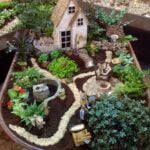Looking for inspiration and guidance on how to transform your home garden into a beautiful and functional outdoor space? In this article, we will explore a variety of home garden landscaping ideas that will help you create the garden of your dreams. From choosing the right plants and designing the layout to incorporating hardscapes and creating an eco-friendly landscape, we’ve got you covered with practical tips and advice.
When it comes to home garden landscaping ideas, the possibilities are endless. Whether you have a small backyard or a spacious yard, there are countless ways to enhance your outdoor space and make it a true oasis. With the right plants, layout design, hardscapes, and color scheme, you can create a visually stunning garden that also serves as a functional outdoor living space.
In this article, we will delve into the key components of successful home garden landscaping. We’ll discuss everything from selecting the right plants for your specific climate and soil conditions to incorporating hardscapes such as pathways, patios, and water features.
Additionally, we’ll explore how to maintain a healthy garden throughout the seasons and implement eco-friendly landscaping practices. By the end of this article, you’ll be equipped with essential knowledge to bring your home garden landscaping vision to life.
Choosing the Right Plants for Your Garden
When it comes to home garden landscaping ideas, choosing the right plants for your garden is a crucial factor in creating a beautiful and thriving outdoor space. From flowers to trees and shrubs, the choices seem endless, but by considering factors such as climate, soil type, and sunlight, you can narrow down the options to find the perfect plants for your garden.
Finding Plants That Thrive in Your Climate
The first step in selecting plants for your garden is to consider the climate in which you live. Different plants thrive in different climates, so it’s important to choose varieties that are well-suited to your specific environment. Whether you live in a dry desert climate or a humid coastal area, there are plenty of plant options available that will flourish in your region.
Understanding Your Soil Type
Another important factor to consider when choosing plants for your garden is the type of soil you have. Some plants prefer well-draining sandy soil, while others thrive in rich, loamy soil. By understanding the composition of your soil, you can select plants that are best suited for the conditions in your garden.
Sunlight Requirements
Lastly, when selecting plants for your garden, it’s essential to consider the amount of sunlight that your garden receives. Some plants require full sun exposure to thrive, while others prefer shady or partially shaded areas. By taking note of the sunlight patterns in your garden, you can choose plants that will receive the appropriate amount of light for healthy growth and development.
By carefully considering these factors, you can choose the right plants for your home garden landscaping ideas and create a lush and vibrant outdoor space that reflects your personal style and thrives for years to come.
Designing the Layout of Your Home Garden
When it comes to designing the layout of your home garden, there are several factors to consider in order to achieve a beautiful and functional space. Here are some key points to keep in mind as you plan:
1. Consider the Sunlight: Take note of how much sunlight each area of your garden receives throughout the day. This will help you determine where to place sun-loving plants and where to create shady retreats.
2. Create Pathways: Design pathways that not only provide access to different parts of your garden but also add visual interest. Whether you choose winding stone paths or straight brick walkways, pathways can enhance the overall design of your garden.
3. Balance and Proportion: Aim for a balanced and proportionate layout by considering the size and shape of different plant beds and features. This will help create a harmonious and visually appealing space.
Incorporating these elements into the layout of your home garden will ensure that you have a well-designed space that is both aesthetically pleasing and practical for everyday use.
Once you have a clear vision for the layout of your home garden, you can start selecting plants and hardscape elements that will complement the design and bring your landscaping ideas to life. By carefully planning the layout, you can create a stunning outdoor oasis that will be enjoyed for years to come.
Incorporating Hardscapes Into Your Landscape
When it comes to creating a picturesque home garden, incorporating hardscapes can add visual interest and functionality to your landscape design. From pathways to patios, hardscaping elements are the non-living features that can enhance the overall look and feel of your outdoor space. Here are some ideas for incorporating hardscapes into your home garden landscaping:
- Pathways: Create a charming pathway through your garden using materials such as gravel, pavers, or stepping stones. Not only do pathways provide a practical way to navigate through your garden, but they also add an inviting and structured element to the overall design.
- Patio or Deck: Consider adding a patio or deck to create an outdoor living space where you can relax and entertain. Whether you prefer the natural look of wood or the durability of concrete, a well-designed patio or deck can become the focal point of your garden.
- Retaining Walls: If your garden has varying elevations, retaining walls not only help prevent soil erosion but also add depth and dimension to your landscape. Use materials like stone or brick to create visually appealing retaining walls that complement the overall aesthetic of your garden.
- Water Features: An elegant fountain or tranquil pond can be an eye-catching addition to any home garden. The sight and sound of water can create a calming atmosphere while adding a touch of sophistication to your outdoor space.
Incorporating hardscapes into your home garden landscaping ideas allows you to personalize and enhance the beauty of your outdoor environment while creating functional spaces for relaxation and entertainment. By carefully selecting and integrating these non-living elements into your landscape design, you can transform your home garden into a visually stunning and enjoyable retreat.
Creating a Functional Outdoor Living Space
When it comes to home garden landscaping ideas, creating a functional outdoor living space is a key aspect to consider. Your garden should be an extension of your home, providing a space for relaxation and entertainment. With the right design and layout, you can transform your garden into a functional outdoor living area that meets your specific needs.
Outdoor Dining Area
One way to create a functional outdoor living space is by incorporating an outdoor dining area. This could include a patio or deck with a dining table and chairs, perfect for enjoying meals al fresco during the warmer months. Consider adding some shade with a pergola or umbrella for added comfort.
Relaxation Zone
In addition to dining, you may want to designate an area for relaxation in your garden. This could include comfortable seating such as lounge chairs or a cozy outdoor sofa. Adding features like a fire pit or water fountain can also enhance the ambiance and create a peaceful retreat within your garden.
Entertainment Space
For those who enjoy entertaining guests, incorporating an entertainment space into your outdoor living area is essential. This could involve setting up an outdoor kitchen with a grill and bar counter, as well as adding ambient lighting and music to set the mood for gatherings.
Creating a functional outdoor living space in your home garden requires thoughtful planning and design. By considering the activities you want to enjoy in your garden, you can tailor the layout and features to suit your lifestyle while beautifying your outdoor space with creative landscaping ideas.
Tips for Maintaining a Healthy Garden
Maintaining a healthy garden is crucial for the success of any home garden landscaping ideas. A well-maintained garden not only looks beautiful but also provides a sense of satisfaction and accomplishment. One of the most important aspects of maintaining a healthy garden is proper watering.
Different plants have different water requirements, so it’s important to research and understand the specific needs of each plant in your garden. Over or under-watering can lead to the decline of plants, so finding the right balance is key.
In addition to watering, regular weeding and pest control are essential for maintaining a healthy garden. Weeds compete with other plants for nutrients and can quickly take over a garden if not kept in check. Insect pests can also wreak havoc on your plants if left unchecked, so it’s important to monitor for signs of infestation and take appropriate measures to control them.
Finally, proper pruning and grooming of plants are necessary to maintain their health and promote good growth. This includes trimming dead or damaged branches, shaping shrubs, and removing spent flowers. Keeping an eye on the overall health of your plants will help you identify any issues early on and take action before they become major problems.
| Aspect | Importance |
|---|---|
| Watering | Proper watering helps in maintaining the health of all kinds of plants |
| Weeding and Pest Control | Weeds and pests compete with the growth of other plants which can lead to their demise if not addressed properly |
| Pruning and Grooming | Maintaining optimal growth by keeping an eye on plant health. |
Eco-Friendly Landscaping Ideas for Your Home Garden
Using eco-friendly landscaping ideas in your home garden not only benefits the environment but also creates a beautiful and sustainable outdoor space for you to enjoy. There are several ways you can incorporate eco-friendly practices into your landscaping, starting with the types of plants you choose.
Opt for native plants that are well-adapted to your local climate and soil conditions, as they will require less water and maintenance compared to non-native species. Additionally, native plants provide essential habitats for local wildlife, contributing to the overall health of the ecosystem.
Another eco-friendly landscaping idea is to minimize the use of chemical fertilizers and pesticides in your garden. Instead, consider implementing natural alternatives such as compost or organic fertilizers to nourish your plants and improve soil health. Integrated pest management techniques can also be utilized, which involve using biological controls and beneficial insects to manage pest populations without harming the environment.
Incorporating water conservation strategies into your home garden landscaping is crucial for sustainability. Consider installing a rain barrel or cistern to capture rainwater for irrigation purposes, or utilize drip irrigation systems to deliver water directly to plant roots while minimizing waste.
Additionally, choosing drought-tolerant plants and implementing mulching techniques can help reduce water usage in your garden. By adopting these eco-friendly landscaping ideas, you can create a thriving and sustainable garden that positively impacts the environment while enhancing the beauty of your outdoor space.
Seasonal Garden Care and Planting Tips
When it comes to maintaining a healthy and vibrant home garden, seasonal care and planting tips play a crucial role in ensuring the success of your landscape. Each season brings its own set of challenges and opportunities for gardening, so it’s essential to adapt your gardening practices accordingly.
During the spring season, focus on preparing your garden for new growth by cleaning up any debris, pruning overgrown plants, and amending the soil with organic matter. This is also the perfect time to plant cool-season crops such as lettuce, spinach, and peas. As the weather warms up, be sure to provide adequate water and keep an eye out for signs of pests or disease.
In the summer months, maintaining proper hydration for your plants is key. Be mindful of watering early in the morning or late in the evening to prevent evaporation. Consider adding mulch to help retain moisture in the soil and reduce weed growth. Additionally, regular deadheading of flowers can encourage continuous blooming throughout the season. Also remember using sustainable lawn care strategies like investing in an electric lawn mower or ensuring your yard waste is properly disposed of.
As fall approaches, start planning for cool-season annuals that can thrive in lower temperatures such as pansies and chrysanthemums. It’s also a great time to divide perennials, remove any diseased plant material, and apply a layer of mulch to protect your garden during winter.
Properly preparing your garden for the colder months will contribute to its health and resilience in the coming seasons. By paying attention to these seasonal garden care tips you can ensure that your home garden remains healthy and beautiful throughout the year.
Using Color and Texture in Home Garden Landscaping
When it comes to home garden landscaping, color and texture play a crucial role in creating an aesthetically pleasing outdoor space. By carefully selecting plants with varying colors and textures, you can create visual interest and depth in your garden. When choosing plants for your garden, consider the color of their blooms and foliage, as well as the texture of their leaves. This can help create a harmonious and visually appealing landscape.
One important consideration when using color in home garden landscaping is to think about the overall color scheme you want to achieve. Some homeowners prefer a more monochromatic look, using different shades of the same color for a cohesive and calming effect. Others may opt for a contrasting color scheme to make a bold statement in their garden.
In addition to color, texture also plays a significant role in home garden landscaping ideas. The texture of a plant’s leaves or flowers can add dimension and interest to your garden. Incorporating plants with different leaf shapes and sizes, such as ornamental grasses or ferns, can create visual diversity and enhance the overall look of your landscape.
| Aspect | Data |
|---|---|
| Plants with varying colors | Create visual interest |
| Color scheme | Monochromatic or contrasting options |
| Texture importance | Adds dimension and interest to the garden |
Conclusion and Final Tips for Home Garden Landscaping Success
In conclusion, creating a beautiful and functional home garden can be a rewarding experience. By choosing the right plants, designing the layout effectively, incorporating hardscapes, and creating an outdoor living space, you can transform your outdoor area into a peaceful retreat. Maintaining a healthy garden is crucial for its long-term success, so be sure to follow our tips for keeping your plants thriving.
When it comes to landscaping ideas for your home garden, think about incorporating eco-friendly elements such as using native plants and implementing sustainable gardening practices. This not only benefits the environment but also creates a more natural and harmonious look for your garden.
As you continue to care for your home garden throughout the seasons, remember to consider color and texture to create visual interest and appeal. Finally, take the time to appreciate all the hard work that goes into maintaining your garden. There’s nothing quite like enjoying the fruits of your labor in a beautifully landscaped outdoor space. We hope these final tips will guide you towards success in your home garden landscaping endeavors.

Welcome to my gardening blog! I am passionate about plants and enjoy sharing my knowledge and experiences with others. In this blog, I will write about everything related to gardening, from tips on how to get started to updates on my own garden projects.





